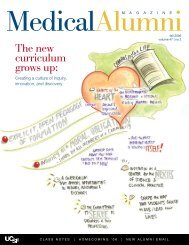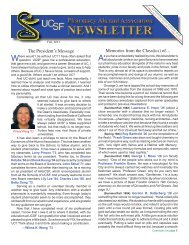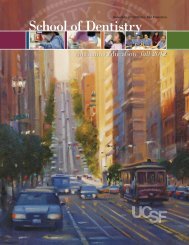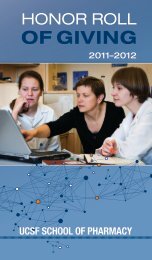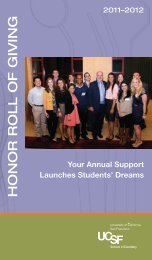here - UCSF Alumni
here - UCSF Alumni
here - UCSF Alumni
You also want an ePaper? Increase the reach of your titles
YUMPU automatically turns print PDFs into web optimized ePapers that Google loves.
Then they go back and tackle theindividual organs in the blockpertinent to that organ’s system.The heart, for example, isdissected when they are studyingthe cardiovascular, pulmonaryand renal systems. This allows forunderstanding in context, explainsTopp. “If you are learning aboutEKG, it’s best to put the anatomytogether with everything t<strong>here</strong> is toknow about the heart, includingphysiological assessment and<strong>UCSF</strong> anatomy lab, 1950s“You need the hands-onexperience of workingwith a human body.It signifies: Welcometo the real world. You aredealing with someonewho has died.” – Allan Basbaummedical treatment.” Opportunitiesto practice clinical procedures suchas suturing and inserting a chesttube have also been added.Five to six students are assignedone cadaver for the duration andmostly left on their own to proceed,with guidance from circulatingfaculty. “They have to figure outhow to work together,” says Topp.“That in itself is so importantbecause medicine today is a veryinteractive practice.”Though far from the timeintensivetradition that most Schoolof Medicine alumni experienced,Basbaum is confident the educationremains effective. “I don’t think weare hurting the training of studentsby cutting back,” he says. “Theydon’t need to know every detailupfront, such as all the digitalnerves. If they are going to becomehand surgeons, then they cango back and learn them.” Toppconcurs, “Immersion is great ifyou are going to be an anatomyinstructor. But if you are going tobe a physician, I’m not sure it’sthe best way to learn anymore.”And both say that despiteadvances in computer simulation –and the expense of obtaining andmaintaining cadavers – dissectionwill stay. “It is absolutely a definingexperience,” says Basbaum.A body of knowledgeIt certainly was for MatthewSchechter, now in his second yearat <strong>UCSF</strong>. “In that very first week ofmedical school, you are suddenlyand forever different from thenon-medical community,”he says. He and his five lab-mateswere assigned a well-muscled andtattooed cadaver. “I was surprisedat the humanity. It’s hard todescribe.” They named him Mick.Over the ensuing months, theygrew to know Mick intimately,and one another. “You can’t spend10 hours a week hovering over acadaver together and not bond,”he laughs. Schechter says thekinesthetic and emotionalexperience of dissecting a bodycreated an understanding that nocomputer or prosection ever could.“I liken it to the difference betweenreading a map of a city and walkingthough it,” he says. “For the rest ofmy career, whenever I’m faced withanatomy, it’s Mick I’ll picture. Notsome abstract concept of vessels,but his vessels. He gave me the giftof knowledge.”Honor your favorite professor!To find out how, contactCarrie Smith, director of developmentand alumni relations,at 415/476-6341 orcsmith@support.ucsf.edu.The <strong>UCSF</strong>Willed BodyProgramIt’s one last way to be useful.That’s one reason why peopledonate their bodies to the <strong>UCSF</strong>Willed Body Program, says AndrewCorson, the program’s coordinator.And it is indeed useful.<strong>UCSF</strong> receives about 300donated bodies a year through theWilled Body Program.Since its inception in 1947 theprogram has supplied cadavers for<strong>UCSF</strong>’s medical and dentalprograms. Today it also suppliescadavers for <strong>UCSF</strong> pharmacy andphysical therapy programs and foranatomy programs at the Cal Stateand community college systemsand private universities throughoutnorthern California. The WilledBody Program also supportsresearch projects such as thetesting of new orthopedic devices,surgical procedural training, alliedhealth education and postgraduatemedical education.About 60 percent of donationsare committed in advance of deathby individuals; the rest comethrough families of the deceased.The bodies come from all overnorthern California, from San LuisObispo to the Oregon border.“Medicine has changed by leapsand bounds, but the fundamentals– the human body and how itworks – have not changed,” saysCorson. “People will always needto know the essentials, and theWilled Body Program is helpingkeep that foundation solid byserving as stewards to donors.Their selfless final act makes sucha difference in our world.”medical alumni magazine | 3




